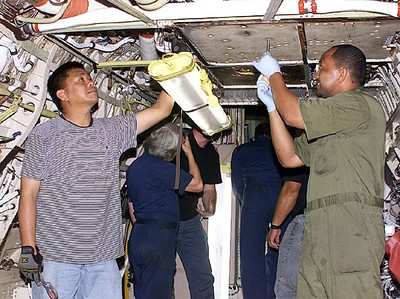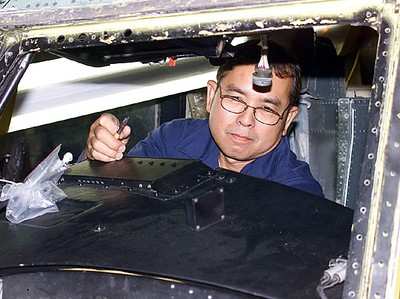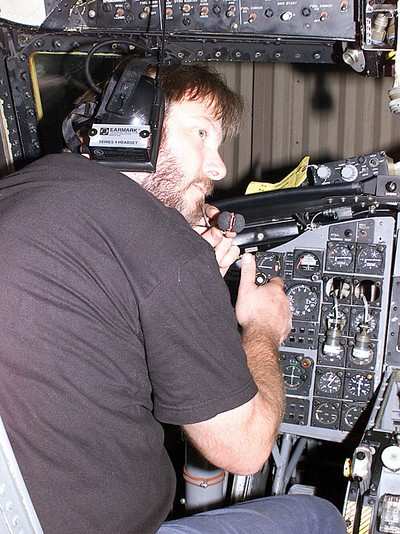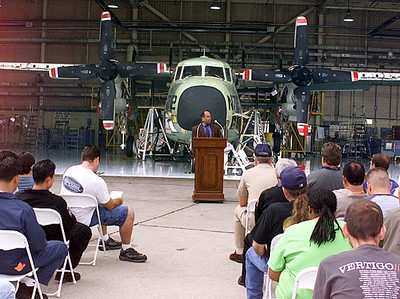Rewired And Ready To Fly, C-2A Takes Off
What started as kickoff meeting a dozen years ago ended Sept. 12
with a formal goodbye at NAVAIR Depot North Island. The first
completely rewired C-2A Greyhound left the Depot after sitting on
the ground for three-and-a-half years. It flew the coop!

Naval aviators flew the improved Greyhound to NAVAIR
Headquarters in Patuxent River, MD, where the $40 million carrier
onboard delivery aircraft will go through the verification process
before being returned to the fleet.
"We (the Depot) mark the completion of the very first rewired
C-2 Greyhound. The idea to rewire this aircraft began in October
1993 and now we mark a milestone as we say farewell," said Joe
Caoile, E-2/C-2 product manager, to product line employees and
special guests.
The rewiring is part of the Service Life Extension Program
(SLEP) and includes structural enhancements that provide the C-2A
with 36,000 landings and 50,000 flight hours. "SLEP is necessary to
make the C-2A a viable and economically maintainable platform until
it is replaced," said Caoile.
The Navy has only 36 Greyhounds. The first of two prototypes
first took to the skies back in 1964. The original Greyhounds were
overhauled in 1973 to extend their operational life, and the Navy
has no new plans on the drawing table to replace the aging C-2A.
This is where SLEP enters the picture.

The NAVAIR Depot North Island workforce is giving each Greyhound
a complete makeover from nose to tail. Each of these aircraft will
go through SLEP to increase its operating service life. The changes
include structural enhancements, rewiring, improvements in avionics
systems, and a new propeller system.
The C-2A provides critical logistics support to carrier strike
groups and without the Greyhound these groups would not survive at
sea. The Greyhound, piloted by experienced naval aviators, delivers
precious cargo, personnel from shore to sea, and mail.
"The aircraft is equipped with miles of wires and thousands of
connectors, clamps, and splices that were installed by Depot
artisans to accomplish its mission," Caoile affirmed. "It also took
thousands of hours to plan and to write the documents and
directives to make the modification come alive. Numerous parts had
to be procured and delivered to put the aircraft back together, and
it took a good number of hours to ground and flight test
everything."
But Caoile said that the immense task could not have been done
without the workforce.
"It is all about the people," he said, "just as AIRSpeed is
about people who are encouraged and empowered to think differently
about their work and about changing their behaviors and habits. The
completion of the (first) aircraft took creativity, innovation and
teamwork from a diverse group of people to make the aircraft come
to life and to fly again."

Caoile credited engineers for developing the design that worked,
logisticians for making the design tangible and real, planners who
made the design and logistics executable, and support groups and
supply for acquiring the logistics that fit the design and planned
its execution.
"This important task took a cross-functional production
workforce to piece it all together. It took a seasoned and heroic
flight crew to make the aircraft do what it was designed to do,"
said Caoile. "And it took a dedicated management to lead a crew,
supervise a shop, and manage a product line to oversee the project
from NAVAIR to engaging in consistent communication with all
stakeholders that made the project a reality."
Caoile mentioned that there are 34 more Greyhounds waiting their
turn to be rewired and one such aircraft at the Depot is 70 percent
complete. "It will take just as much dedication and teaming by the
same diverse group of people to finish the aircraft. We have no
doubt that the Depot will complete this all-important mission," he
said emphatically.
"This has been a long, hard journey with many challenges," said
engineer Donald Sano, the depot's C-2 SLEP integrated product team
(IPT) lead. "We crossed a number of hills and valleys."
Sano said that in 22 months, the team red lined, revised, and
created 13,000 pages of manufacturing drawings and technical
publications. "This alone was an amazing effort," he said. "In the
same 22-month period, the team oversaw the manufacture of more than
100,000 parts and also created a unique data base which will help
the fleet in the years to come with 260,000 entries and
counting."
According to Sano, the team installed 23 miles of wiring.
He thanked the rewire team after demonstration testing -- a
more reliable and much safer aircraft." Sano also recognized the
leadership of the C-2 Integrated Process Team at NAVAIR
Headquarters who attended the ceremony.
"The rewire team and the Strategic Business Unit set a new
benchmark and pride of ownership. Working together as team you
accomplished what very few people thought that we could accomplish
in this amount of time." Sano also credited Daniel Plale, C-2
rewire team leader, "for his leadership, commitment and driving
attention to detail and for inspiring his team to go above and
beyond time and time again."
Napoleon Julienne, planning team lead, said, "This has been a
long three-and-a-half years on this aircraft with a lot of
meetings, some good and some not so good. We did make it through
some tight schedules," he said.

Brian Delaney, the execution team lead, said, "We design a
product, we plan a product, and we execute a product. My hat is off
to our electrical artisans, sheet metal mechanics, and aircraft
mechanics for their outstanding job."
Depot C-2 test pilot Cmdr. John Lemmon thanked everyone who
worked on the Greyhound. "Considering the amount of time that the
aircraft sat on the ground, it took us just two flights to get the
functional check flight done. This is amazing!"
Lemmon said that communication is always critical. "AIRSpeed
forces us to communicate much better than we have in the past and
to quit trying to reinvent the wheel on things that we are doing,"
he said. "Communication was key between the all the teams to get
the aircraft to the Test Line, and fly it to find out what was
wrong with it and come up with the fixes that needed to be done to
get the aircraft to Patuxent River to finish the demonstration
testing."
James Fingerle, NAVAIR PMA-231 IPT colead, said, "WOW! I can't
believe that this day is finally here. The completion of this task
was truly a team effort, and I can't overestimate my appreciation
to everyone on the various teams. The job was done right and done
early and it doesn't get any better than that."
IPT co-lead Lt. Cmdr. Sean McDermott said that the Navy
recognized the need to remove kapton wiring from the Greyhound in
1994. "Some 70 percent of the aircraft was wired with kapton
wiring," he said. "It's dangerous and deadly and needed to be taken
care of. Somehow the job took a little while, but you did it."
"The C-2 is the only carrier onboard delivery fixed wing
aircraft with long legs and the air wing dies without this
airplane," said NAVAIR Depot North Island Commanding Officer Capt.
Tim Trainer. "The Greyhound is a critical aircraft because it
delivers people, parts and items that need to be out to that
forward deployed sea-based carrier. The C-2 impacts our ability to
project forces across the world."
Trainer credited Caoile for showing the Depot how to conduct
business when he said, "We going to take your processes and export
them across the Depot."
Trainer ended the ceremony by handing out Commanding Officer's
coins to the rewire team.
 ANN's Daily Aero-Linx (05.06.25)
ANN's Daily Aero-Linx (05.06.25) ANN's Daily Aero-Term (05.06.25): Ultrahigh Frequency (UHF)
ANN's Daily Aero-Term (05.06.25): Ultrahigh Frequency (UHF) ANN FAQ: Q&A 101
ANN FAQ: Q&A 101 Classic Aero-TV: Virtual Reality Painting--PPG Leverages Technology for Training
Classic Aero-TV: Virtual Reality Painting--PPG Leverages Technology for Training Airborne 05.02.25: Joby Crewed Milestone, Diamond Club, Canadian Pilot Insurance
Airborne 05.02.25: Joby Crewed Milestone, Diamond Club, Canadian Pilot Insurance






